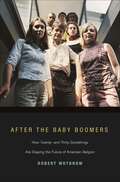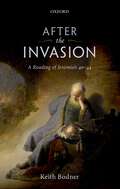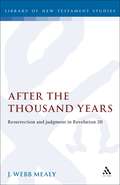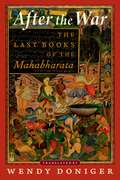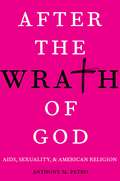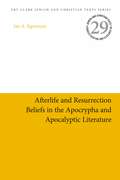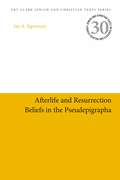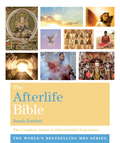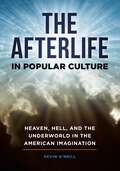- Table View
- List View
After Secular Law (The Cultural Lives of Law)
by Winnifred Fallers Sullivan Robert A. Yelle Mateo Taussig-RubboMany today place great hope in law as a vehicle for the transformation of society and accept that law is autonomous, universal, and above all, secular. Yet recent scholarship has called into question the simplistic narrative of a separation between law and religion and blurred the boundaries between these two categories, enabling new accounts of their relation that do not necessarily either collapse them together or return law to a religious foundation. This work gives special attention to the secularism of law, exploring how law became secular, the phenomenology of the legal secular, and the challenges that lingering religious formations and other aspects of globalization pose for modern law's self-understanding. Bringing together scholars with a variety of perspectives and orientations, it provides a deeper understanding of the interconnections between law and religion and the unexpected histories and anthropologies of legal secularism in a globalizing modernity.
After Secularism: Rethinking Religion in Global Politics
by E. WilsonHaving destabilized dominant assumptions about the nature of religion, there is now a need to develop new ways of thinking about this ever-present phenomenon in global politics. This book outlines a new approach to understanding religion and its relationship with politics in the West and globally for International Relations.
After Terror: Promoting Dialogue Among Civilizations
by Akbar Ahmed Brian ForstAfter Terror presents sustained reflections by some of the world's most celebrated thinkers on the most pressing question of our time: how can we find ways to defuse the ticking bombs of terrorism and excessive interventions against it? It offers an antidote to the fatalistic global holy war perspective that afflicts much contemporary thought, focusing instead on the principles, issues, and acts needed to shift course from alienation and conflict to a path of sanity and goodwill among cultures and civilizations. The central aim of the book is to advance contemporary thinking on the causes and implications of 9/11 and thus provide the essential elements of a blueprint for humanity. It features 28 original essays by some of the world's leading public figures, scholars, and religious leaders, including Benjamin Barber, Zbigniew Brzezinski, Jean Bethke Elshtain, Amitai Etzioni, Bernard Lewis, Martin Marty, Queen Noor, Joseph Nye, Judea Pearl, Jonathan Sacks, Ravi Shankar, Bishop Desmond Tutu, E.O. Wilson and James D. Wolfensohn. After Terror attests to the power of dialogue and mutual understanding and the possibility of tolerance, respect, cooperation, and commitment. Without ignoring the dangers of the modern world, it points to a future in which people can celebrate both the fundamental sentiments and interests that we share and the diversities that make us human.
After Terror: Promoting Dialogue Among Civilizations
by Akbar S. Ahmed Brian ForstAfter Terror presents sustained reflections by some of the world's most celebrated thinkers on the most pressing question of our time: how can we find ways to defuse the ticking bombs of terrorism and excessive interventions against it? It offers an antidote to the fatalistic global holy war perspective that afflicts much contemporary thought, focusing instead on the principles, issues, and acts needed to shift course from alienation and conflict to a path of sanity and goodwill among cultures and civilizations. The central aim of the book is to advance contemporary thinking on the causes and implications of 9/11 and thus provide the essential elements of a blueprint for humanity. It features 28 original essays by some of the world's leading public figures, scholars, and religious leaders, including Benjamin Barber, Zbigniew Brzezinski, Jean Bethke Elshtain, Amitai Etzioni, Bernard Lewis, Martin Marty, Queen Noor, Joseph Nye, Judea Pearl, Jonathan Sacks, Ravi Shankar, Bishop Desmond Tutu, E.O. Wilson and James D. Wolfensohn. After Terror attests to the power of dialogue and mutual understanding and the possibility of tolerance, respect, cooperation, and commitment. Without ignoring the dangers of the modern world, it points to a future in which people can celebrate both the fundamental sentiments and interests that we share and the diversities that make us human.
After the Baby Boomers: How Twenty- and Thirty-Somethings Are Shaping the Future of American Religion
by Robert WuthnowMuch has been written about the profound impact the post-World War II baby boomers had on American religion. But the lifestyles and beliefs of the generation that has followed--and the influence these younger Americans in their twenties and thirties are having on the face of religion--are not so well understood. It is this next wave of post-boomers that Robert Wuthnow examines in this illuminating book. What are their churchgoing habits and spiritual interests and needs? How does their faith affect their families, their communities, and their politics? Interpreting new evidence from scores of in-depth interviews and surveys, Wuthnow reveals a generation of younger adults who, unlike the baby boomers that preceded them, are taking their time establishing themselves in careers, getting married, starting families of their own, and settling down--resulting in an estimated six million fewer regular churchgoers. He shows how the recent growth in evangelicalism is tapering off, and traces how biblical literalism, while still popular, is becoming less dogmatic and more preoccupied with practical guidance. At the same time, Wuthnow explains how conflicts between religious liberals and conservatives continue--including among new immigrant groups such as Hispanics and Asians--and how in the absence of institutional support many post-boomers have taken a more individualistic, improvised approach to spirituality. Wuthnow's fascinating analysis also explores the impacts of the Internet and so-called virtual churches, and the appeal of megachurches. After the Baby Boomers offers us a tantalizing look at the future of American religion for decades to come.
After the Baby Boomers: How Twenty- and Thirty-Somethings Are Shaping the Future of American Religion (PDF)
by Robert WuthnowMuch has been written about the profound impact the post-World War II baby boomers had on American religion. But the lifestyles and beliefs of the generation that has followed--and the influence these younger Americans in their twenties and thirties are having on the face of religion--are not so well understood. It is this next wave of post-boomers that Robert Wuthnow examines in this illuminating book. What are their churchgoing habits and spiritual interests and needs? How does their faith affect their families, their communities, and their politics? Interpreting new evidence from scores of in-depth interviews and surveys, Wuthnow reveals a generation of younger adults who, unlike the baby boomers that preceded them, are taking their time establishing themselves in careers, getting married, starting families of their own, and settling down--resulting in an estimated six million fewer regular churchgoers. He shows how the recent growth in evangelicalism is tapering off, and traces how biblical literalism, while still popular, is becoming less dogmatic and more preoccupied with practical guidance. At the same time, Wuthnow explains how conflicts between religious liberals and conservatives continue--including among new immigrant groups such as Hispanics and Asians--and how in the absence of institutional support many post-boomers have taken a more individualistic, improvised approach to spirituality. Wuthnow's fascinating analysis also explores the impacts of the Internet and so-called virtual churches, and the appeal of megachurches. After the Baby Boomers offers us a tantalizing look at the future of American religion for decades to come.
After the Holocaust: Challenging the Myth of Silence
by David Cesarani Eric J. SundquistFor the last decade scholars have been questioning the idea that the Holocaust was not talked about in any way until well into the 1970s. After the Holocaust: Challenging the Myth of Silence is the first collection of authoritative, original scholarship to expose a serious misreading of the past on which, controversially, the claims for a ‘Holocaust industry’ rest. Taking an international approach this bold new book exposes the myth and opens the way for a sweeping reassessment of Jewish life in the postwar era, a life lived in the pervasive, shared awareness that Jews had narrowly survived a catastrophe that had engulfed humanity as a whole but claimed two-thirds of their number. The chapters include: an overview of the efforts by survivor historians and memoir writers to inform the world of the catastrophe that had befallen the Jews of Europe an evaluation of the work of survivor-historians and memoir writers new light on the Jewish historical commissions and the Jewish documentation centres studies of David Boder, a Russian born psychologist who recorded searing interviews with survivors, and the work of philosophers, social thinkers and theologians theatrical productions by survivors and the first films on the theme made in Hollywood how the Holocaust had an impact on the everyday life of Jews in the USA and a discussion of the different types, and meanings, of ‘silence’. A breakthrough volume in the debate about the ‘Myth of Silence’, this is a must for all students of Holocaust and genocide.
After the Holocaust: Challenging the Myth of Silence
by David Cesarani Eric J. SundquistFor the last decade scholars have been questioning the idea that the Holocaust was not talked about in any way until well into the 1970s. After the Holocaust: Challenging the Myth of Silence is the first collection of authoritative, original scholarship to expose a serious misreading of the past on which, controversially, the claims for a ‘Holocaust industry’ rest. Taking an international approach this bold new book exposes the myth and opens the way for a sweeping reassessment of Jewish life in the postwar era, a life lived in the pervasive, shared awareness that Jews had narrowly survived a catastrophe that had engulfed humanity as a whole but claimed two-thirds of their number. The chapters include: an overview of the efforts by survivor historians and memoir writers to inform the world of the catastrophe that had befallen the Jews of Europe an evaluation of the work of survivor-historians and memoir writers new light on the Jewish historical commissions and the Jewish documentation centres studies of David Boder, a Russian born psychologist who recorded searing interviews with survivors, and the work of philosophers, social thinkers and theologians theatrical productions by survivors and the first films on the theme made in Hollywood how the Holocaust had an impact on the everyday life of Jews in the USA and a discussion of the different types, and meanings, of ‘silence’. A breakthrough volume in the debate about the ‘Myth of Silence’, this is a must for all students of Holocaust and genocide.
After the Invasion: A Reading of Jeremiah 40-44
by Keith BodnerIn the wake of the Babylonian destruction of Jerusalem and the displacement of exile, there is a unique story that is told about the remnant left behind after the invasion. The narrative of Jeremiah 40—44 unfolds the challenges and crises of this community who remain in Judah as they negotiate their survival following the catastrophe of Jerusalem's fall. After the Invasion shares the often overlooked, but compelling story that emerges from the five later chapters of Jeremiah. Keith Bodner expertly reveals the assortment of personalities, geographic locations, shifts in point of view, temporal compression, and layers of irony. Primary focused on the narrative design of this text, Professor Bodner proves that these chapters form a creative and sophisticated narrative that make a rich, though perhaps underestimated, contribution to the book of Jeremiah as a whole.
After the Thousand Years: Resurrection and Judgment in Revelation 20 (The Library of New Testament Studies #70)
by J. Webb MealyA fresh and highly illuminating approach to what is perhaps the most difficult chapter in the most difficult book of the New Testament. Mealy employs a carefully developed methodology which draws fully on the special literary techniques of Revelation, particularly its extensive use of internal cross-references, multivalent images and symbols, and complex Old Testament reminiscences. With its central thesis that Revelation 20.7-10 and 20.11-15 offer parallel representations of the resurrection and final judgment of the unrepentant, this study is destined to become a benchmark for future discussions not only of the millennium, but of the literary workings of Revelation as a whole.
After the War: The Last Books of the Mahabharata
by Wendy DonigerAfter the War is a new translation of the final part of the Mahabharata, the great Sanskrit Epic poem about a devastating fraternal war. In this aftermath of the great war, the surviving heroes find various deaths, ranging from a drunken debacle in which they kill many of their own comrades to suicide through meditation and, finally, magical transportation to both heaven and hell. Bereaved mothers and widows on earth are comforted when their dead sons and husbands are magically conjured up from heaven and emerge from a river to spend one glorious night on earth with their loved ones. Ultimately, the bitterly opposed heroes of both sides are reconciled in heaven, but only when they finally let go of the vindictive masculine pride that has made each episode of violence give rise to another. Throughout the text, issues of truth and reconciliation, of the competing beliefs in various afterlives, and of the ultimate purpose of human life are debated. This last part of the Mahabharata has much to tell us both about the deep wisdom of Indian poets during the centuries from 300 BCE to 300 CE (the dates of the recension of this enormous text) and about the problems that we ourselves confront in the aftermath of our own genocidal and internecine wars. The author, a distinguished translator of Sanskrit texts (including the Rig Veda, the Laws of Manu, and the Kamasutra), puts the text into clear, flowing, contemporary prose, with a comprehensive but unintrusive critical apparatus. This book will delight general readers and enlighten students of Indian civilization and of great world literature.
After the War: The Last Books of the Mahabharata
by Wendy DonigerAfter the War is a new translation of the final part of the Mahabharata, the great Sanskrit Epic poem about a devastating fraternal war. In this aftermath of the great war, the surviving heroes find various deaths, ranging from a drunken debacle in which they kill many of their own comrades to suicide through meditation and, finally, magical transportation to both heaven and hell. Bereaved mothers and widows on earth are comforted when their dead sons and husbands are magically conjured up from heaven and emerge from a river to spend one glorious night on earth with their loved ones. Ultimately, the bitterly opposed heroes of both sides are reconciled in heaven, but only when they finally let go of the vindictive masculine pride that has made each episode of violence give rise to another. Throughout the text, issues of truth and reconciliation, of the competing beliefs in various afterlives, and of the ultimate purpose of human life are debated. This last part of the Mahabharata has much to tell us both about the deep wisdom of Indian poets during the centuries from 300 BCE to 300 CE (the dates of the recension of this enormous text) and about the problems that we ourselves confront in the aftermath of our own genocidal and internecine wars. The author, a distinguished translator of Sanskrit texts (including the Rig Veda, the Laws of Manu, and the Kamasutra), puts the text into clear, flowing, contemporary prose, with a comprehensive but unintrusive critical apparatus. This book will delight general readers and enlighten students of Indian civilization and of great world literature.
After the Wrath of God: AIDS, Sexuality, & American Religion
by Anthony M. PetroOn a cold February morning in 1987, amidst freezing rain and driving winds, a group of protesters stood outside of the Unitarian Universalist Church in Amherst, Massachusetts. The target of their protest was the minister inside, who was handing out condoms to his congregation while delivering a sermon about AIDS, dramatizing the need for the church to confront the seemingly ever-expanding crisis. The minister's words and actions were met with a standing ovation from the overflowing audience, but he could not linger to enjoy their applause. Having received threats in advance of the service, he dashed out of the sanctuary immediately upon finishing his sermon. Such was the climate for religious AIDS activism in the 1980s. In After the Wrath of God, Anthony Petro vividly narrates the religious history of AIDS in America. Delving into the culture wars over sex, morality, and the future of the American nation, he demonstrates how religious leaders and AIDS activists have shaped debates over sexual morality and public health from the 1980s to the present day. While most attention to religion and AIDS foregrounds the role of the Religious Right, Petro takes a much broader view, encompassing the range of mainline Protestant, evangelical, and Catholic groups--alongside AIDS activist organizations--that shaped public discussions of AIDS prevention and care in the U.S. Petro analyzes how the AIDS crisis prompted American Christians across denominations and political persuasions to speak publicly about sexuality--especially homosexuality--and to foster a moral discourse on sex that spoke not only to personal concerns but to anxieties about the health of the nation. He reveals how the epidemic increased efforts to advance a moral agenda regarding the health benefits of abstinence and monogamy, a legacy glimpsed as much in the traction gained by abstinence education campaigns as in the more recent cultural purchase of gay marriage. The first book to detail the history of religion and the AIDS epidemic in the U.S., After the Wrath of God is essential reading for anyone concerned with the intersection of religion and public health.
After the Wrath of God: AIDS, Sexuality, & American Religion
by Anthony M. PetroOn a cold February morning in 1987, amidst freezing rain and driving winds, a group of protesters stood outside of the Unitarian Universalist Church in Amherst, Massachusetts. The target of their protest was the minister inside, who was handing out condoms to his congregation while delivering a sermon about AIDS, dramatizing the need for the church to confront the seemingly ever-expanding crisis. The minister's words and actions were met with a standing ovation from the overflowing audience, but he could not linger to enjoy their applause. Having received threats in advance of the service, he dashed out of the sanctuary immediately upon finishing his sermon. Such was the climate for religious AIDS activism in the 1980s. In After the Wrath of God, Anthony Petro vividly narrates the religious history of AIDS in America. Delving into the culture wars over sex, morality, and the future of the American nation, he demonstrates how religious leaders and AIDS activists have shaped debates over sexual morality and public health from the 1980s to the present day. While most attention to religion and AIDS foregrounds the role of the Religious Right, Petro takes a much broader view, encompassing the range of mainline Protestant, evangelical, and Catholic groups--alongside AIDS activist organizations--that shaped public discussions of AIDS prevention and care in the U.S. Petro analyzes how the AIDS crisis prompted American Christians across denominations and political persuasions to speak publicly about sexuality--especially homosexuality--and to foster a moral discourse on sex that spoke not only to personal concerns but to anxieties about the health of the nation. He reveals how the epidemic increased efforts to advance a moral agenda regarding the health benefits of abstinence and monogamy, a legacy glimpsed as much in the traction gained by abstinence education campaigns as in the more recent cultural purchase of gay marriage. The first book to detail the history of religion and the AIDS epidemic in the U.S., After the Wrath of God is essential reading for anyone concerned with the intersection of religion and public health.
After World Religions: Reconstructing Religious Studies (Religion in Culture)
by Christopher R Cotter David G. RobertsonThe World Religions Paradigm has been the subject of critique and controversy in Religious Studies for many years. After World Religions provides a rationale for overhauling the World Religions curriculum, as well as a roadmap for doing so. The volume offers concise and practical introductions to cutting-edge Religious Studies method and theory, introducing a wide range of pedagogical situations and innovative solutions. An international team of scholars addresses the challenges presented in their different departmental, institutional, and geographical contexts. Instructors developing syllabi will find supplementary reading lists and specific suggestions to help guide their teaching. Students at all levels will find the book an invaluable entry point into an area of ongoing scholarly debate.
After World Religions: Reconstructing Religious Studies (Religion in Culture)
by Christopher R Cotter David G. RobertsonThe World Religions Paradigm has been the subject of critique and controversy in Religious Studies for many years. After World Religions provides a rationale for overhauling the World Religions curriculum, as well as a roadmap for doing so. The volume offers concise and practical introductions to cutting-edge Religious Studies method and theory, introducing a wide range of pedagogical situations and innovative solutions. An international team of scholars addresses the challenges presented in their different departmental, institutional, and geographical contexts. Instructors developing syllabi will find supplementary reading lists and specific suggestions to help guide their teaching. Students at all levels will find the book an invaluable entry point into an area of ongoing scholarly debate.
Afterlife: A History of Life after Death
by Philip C. AlmondFor in that sleep of death what dreams may come? The end of life has never meant the extinction of hope. People perpetually have yearned for, and often been terrified by, continuance beyond the horizon of mortality. Ranging across time and space, Philip Almond here takes his readers on a remarkable journey to worlds both of torment and delight. He travels to the banks of the Styx, where Charon the grizzled boatman ferries a departing spirit across the river only if a gold obol is first placed for payment on the tongue of its corpse. He transports us to the legendary Isles of the Blessed, walks the hallowed ground of the Elysian Fields and plumbs the murky depths of Tartarus, primordial dungeon of the Titans. The pitiable souls of the damned are seen to clog the soot-filled caverns of Lucifer even as the elect ascend to Paradise. Including medieval fears for the fate of those consumed by cannibals, early modern ideas about the Last Day and modern scientific explorations of the domains of the dead, this first full treatment of the afterlife in Western thought evokes many rich imaginings of Heaven, Hell, Purgatory and Limb
Afterlife: What You Need to Know about Heaven, the Hereafter & Near-Death Experiences
by Hank HanegraaffIf there was ever a need-to-know book, Afterlife is it. On his daily call-in radio show, the most common questions Hanegraff fields are about the hereafter. For instance, millions are voraciously reading about the near-death experiences of young children. Consumers are desperate for knowledge and reassurance about what comes after life on the earth. Hank Hanegraff, one of the most remarkable theological minds of the 21st century, explains the marvelous way this physical life connects our past to our eternal future. Afterlife gives reader a clear and concrete understanding about what happens after death to us and to those we love.
Afterlife and Resurrection Beliefs in the Apocrypha and Apocalyptic Literature (Jewish and Christian Texts)
by Jan Age SigvartsenJan A. Sigvartsen seeks to examine the immense interest in life after death, and speculation about the fates awaiting both the righteous and the wicked, that proliferated in the Second Temple period. In this volume Sigvartsen explores the Apocrypha and the apocalyptic writings in the Pseudepigrapha. He identifies the numerous afterlife and resurrection beliefs and presents an analysis that enables readers to easily understand and compare the wide-ranging beliefs regarding the afterlife that these texts hold.A careful reading of these resurrection passages, including passages appearing in Sirach, Maccabees, the Sibylline Oracles and the Ezra texts, reveals that most of the distinct views on life-after-death, regardless of their complexity, show little evidence of systematic development relational to one another, and are often supported by several key passages or shared motifs from texts that later became a part of the TaNaKh. Sigvartsen also highlights the factors that may have influenced the development of so many different resurrection beliefs; including anthropology, the nature of the soul, the scope of the resurrection, the number and function of judgments, and the final destination of the righteous and the wicked. Sigvartsen's study provides a deeper understanding of how the “TaNaKh” was read by different communities during this important period, and the role it played in the development of the resurrection belief – a central article of faith in both Christianity and Rabbinic Judaism.
Afterlife and Resurrection Beliefs in the Apocrypha and Apocalyptic Literature (Jewish and Christian Texts)
by Jan Age SigvartsenJan A. Sigvartsen seeks to examine the immense interest in life after death, and speculation about the fates awaiting both the righteous and the wicked, that proliferated in the Second Temple period. In this volume Sigvartsen explores the Apocrypha and the apocalyptic writings in the Pseudepigrapha. He identifies the numerous afterlife and resurrection beliefs and presents an analysis that enables readers to easily understand and compare the wide-ranging beliefs regarding the afterlife that these texts hold.A careful reading of these resurrection passages, including passages appearing in Sirach, Maccabees, the Sibylline Oracles and the Ezra texts, reveals that most of the distinct views on life-after-death, regardless of their complexity, show little evidence of systematic development relational to one another, and are often supported by several key passages or shared motifs from texts that later became a part of the TaNaKh. Sigvartsen also highlights the factors that may have influenced the development of so many different resurrection beliefs; including anthropology, the nature of the soul, the scope of the resurrection, the number and function of judgments, and the final destination of the righteous and the wicked. Sigvartsen's study provides a deeper understanding of how the “TaNaKh” was read by different communities during this important period, and the role it played in the development of the resurrection belief – a central article of faith in both Christianity and Rabbinic Judaism.
Afterlife and Resurrection Beliefs in the Pseudepigrapha (Jewish and Christian Texts)
by Jan Age SigvartsenJan A. Sigvartsen seeks to examine the immense interest in life after death, and speculation about the fates awaiting both the righteous and the wicked, that proliferated in the Second Temple period. In this volume Sigvartsen analyses the texts of the Pseudepigrapha, identifies the numerous afterlife and resurrection beliefs they contain, and presents an analysis of these beliefs and how they functioned in the Second Temple period.A careful reading of these diverse resurrection passages – from testaments to wisdom, philosophical literature, and prayers – reveals that most of these distinct life-after-death views, regardless of their complexity, show little evidence of systematic development relational to one another, and are often supported by several key passages or shared motifs from texts that later became a part of the TaNaKh. This volume examines testaments from Adam to the Twelve Patriarchs, expansions of stories and legends such as Joseph and Aseneth and the ladder of Jacob, and texts such as 4 Maccabees, before finally considering the posthumous body, the nature of the soul, and anthropological implications. Sigvartsen's study provides a deeper understanding of how texts that later became a part of the TaNaKh were read by different communities during this important period, and the role they played in the development of the resurrection belief – a central article of faith in both Christianity and Rabbinic Judaism.This volume is a companion to Sigvartsen's work on afterlife and resurrection in the Apocrypha and the apocalyptic literature of the Pseudepigrapha.
The Afterlife Bible: The Complete Guide to Otherworldly Experience (Subject Bible Ser.)
by Sarah BartlettThe Afterlife Bible is not only a definitive companion to the beliefs, history, mythology, and science of the afterlife, but also a practical guide to working within the spiritual realm for comfort and healing in this life.Revealing the fascinating beliefs in the afterlife, from ancient myth and religion to contemporary spiritual faiths, including the places, encounters, and supernatural contacts between worlds, The Afterlife Bible also looks at the role of mediums and healers, and the scientific and psychic evidence for their practice. In the practical sections of the book, learn how to meet the spiritual beings who dwell beyond the earth plane, from spirit guides to guardian angels, and discover the soul's journey through past lives and current regression techniques. Exercises include meditation, channelling, dream work, astral travel, scrying, mediumship, and automatic writing to help you connect with the worlds beyond.
The Afterlife in Popular Culture: Heaven, Hell, and the Underworld in the American Imagination
by Kevin O'NeillThe Afterlife in Popular Culture: Heaven, Hell, and the Underworld in the American Imagination gives students a fresh look at how Americans view the afterlife, helping readers understand how it's depicted in popular culture.What happens to us when we die? The book seeks to explore how that question has been answered in American popular culture. It begins with five framing essays that provide historical and intellectual background on ideas about the afterlife in Western culture. These essays are followed by more than 100 entries, each focusing on specific cultural products or authors that feature the afterlife front and center. Entry topics include novels, film, television shows, plays, works of nonfiction, graphic novels, and more, all of which address some aspect of what may await us after our passing.This book is unique in marrying a historical overview of the afterlife with detailed analyses of particular cultural products, such as films and novels. In addition, it covers these topics in nonspecialist language, written with a student audience in mind. The book provides historical context for contemporary depictions of the afterlife addressed in the entries, which deal specifically with work produced in the 20th and 21st centuries.
The Afterlife in Popular Culture: Heaven, Hell, and the Underworld in the American Imagination
by Kevin O'NeillThe Afterlife in Popular Culture: Heaven, Hell, and the Underworld in the American Imagination gives students a fresh look at how Americans view the afterlife, helping readers understand how it's depicted in popular culture.What happens to us when we die? The book seeks to explore how that question has been answered in American popular culture. It begins with five framing essays that provide historical and intellectual background on ideas about the afterlife in Western culture. These essays are followed by more than 100 entries, each focusing on specific cultural products or authors that feature the afterlife front and center. Entry topics include novels, film, television shows, plays, works of nonfiction, graphic novels, and more, all of which address some aspect of what may await us after our passing.This book is unique in marrying a historical overview of the afterlife with detailed analyses of particular cultural products, such as films and novels. In addition, it covers these topics in nonspecialist language, written with a student audience in mind. The book provides historical context for contemporary depictions of the afterlife addressed in the entries, which deal specifically with work produced in the 20th and 21st centuries.
The Afterlife in the Arab Spring
by Amira MittermaierDeath lies at the beginning of the Arab uprisings, and death continues to haunt them. Most narratives about the ‘Arab Spring’ begin with Mohammed Bouazizi, a Tunisian fruit vendor who set himself on fire. Egyptian protesters in turn referred to Khaled Said, a young man from Alexandria whom the police had beaten to death. This book places death at the centre of its engagement with the Arab uprisings, counterrevolutions, and their aftermaths. It examines martyrdom and commemoration as performative acts through which death and life are infused with meaning. Conversely, it shows how, in the making, remembering, and erasing of martyrs, hierarchies are (re)produced and possible futures are foreclosed. The contributors argue that critical anthropological engagement with death, martyrdom, and afterlife is indispensable if we want to understand the making of pasts and futures in a revolutionary present. This book was originally published as a special issue of Ethnos: Journal of Anthropology.



